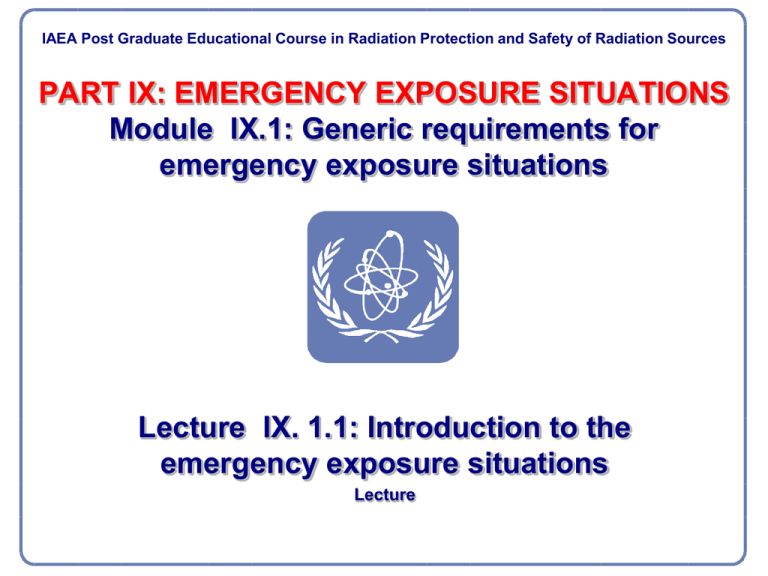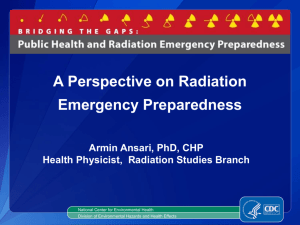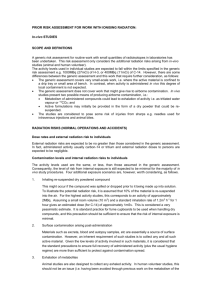Emergency Exposure situation
advertisement

IAEA Post Graduate Educational Course in Radiation Protection and Safety of Radiation Sources PART IX: EMERGENCY EXPOSURE SITUATIONS Module IX.1: Generic requirements for emergency exposure situations Lecture IX. 1.1: Introduction to the emergency exposure situations Lecture Objective To become familiar with: 1. the emergency exposure situations, 2. the difference between emergency preparedness and emergency response and 3. scope of requirements for emergency exposure situations. Module IX.1 Generic requirements for emergency exposure situations 2 Content 1. What is a radiological emergency? 2. What is emergency exposure situation? 3. Examples of radiological emergency situations 4. What is Emergency Preparedness and Response? 5. Scope of Requirements for emergency exposure situations Module IX.1 Generic requirements for emergency exposure situations 3 What is a radiological emergency? A radiological emergency is an emergency in which there is, or is perceived to be, a hazard due to radiation exposure from a source. As sources of radiation are used in various fields, including industry, medicine and research, radiological emergencies may occur anywhere. Module IX.1 Generic requirements for emergency exposure situations 4 What is emergency exposure situation? is a situation of exposure that arises as a result of an accident, a malicious act, or any other unexpected event, and requires prompt action in order to avoid or to reduce adverse consequences. Preventive actions and mitigatory actions have to be considered before an emergency exposure situation arises. Once an emergency exposure situation actually occurs, exposures can be reduced only by implementing protective actions. Module IX.1 Generic requirements for emergency exposure situations 5 Examples of radiological emergency situations These are examples of radiological emergency situations and associated conditions that may facing: Medical Symptoms of Radiation Exposure Loss or Theft of Dangerous Radioactive Source Public Radioactive Contamination/Exposure Transport emergency involving radioactive materials Detection of Elevated Radiation Levels Presence of Radiological Dispersal Device (RDD) Module IX.1 Generic requirements for emergency exposure situations 6 Medical symptoms of radiation exposure Many radiological emergencies are first identified through medical examinations of persons that have been exposed to radiation. A physician should consider the possibility of radiation induced injures when facing burns without an apparent cause, suspicions expressed by the patient that some 'object' was making them sick, or a patient being in a profession where there is an increased risk of encountering a dangerous source (e.g. scrap metal dealer). Module IX.1 Generic requirements for emergency exposure situations 7 Hazards: The patient could be suffering from radiation injuries warranting specialized treatment. Furthermore, the discovery of symptoms of radiation exposure could indicate a public radioactive contamination or exposure emergency, and the source of exposure or contamination could continue to represent a severe hazard unknown to those in the vicinity. Module IX.1 Generic requirements for emergency exposure situations 8 Loss or theft of a dangerous source Sources containing sufficient radioactive material to qualify as dangerous are used for various purposes, both industrial and medical. Even though safety and security provisions are put in place to prevent such sources from being lost or stolen, such events occur and constitute radiological emergencies. Module IX.1 Generic requirements for emergency exposure situations 9 Hazards: It must be assumed that the source may be in the possession of people who may not know its nature and hazard, who can handle it, break it and spread contamination. Unknowingly handling unshielded\ unconfined dangerous quantities of radioactive material can result in permanent injuries from external exposure or inadvertent ingestion and in localized contamination, requiring cleanup. Module IX.1 Generic requirements for emergency exposure situations 10 Public radioactive contamination or exposure Radioactive contamination of the public or of public places could occur as the result of members of the public, unaware of the hazard, handling a lost or stolen dangerous source. Contamination could also occur as the result of a deliberate act. These emergencies are often discovered, unfortunately, after several people have been exposed and there has been considerable spread of radioactive material. Module IX.1 Generic requirements for emergency exposure situations 11 Hazards: Contaminated or exposed individuals could suffer radiation injuries warranting specialized treatment. The source of exposure or contamination could represent a severe hazard unsuspected by those in the vicinity. The material could be further dispersed by human activity and could involve widespread contamination of areas and local products. Module IX.1 Generic requirements for emergency exposure situations 12 Hazards (cont.): If public and financial institution concerns are not promptly addressed, there can be significant adverse and inappropriate public reaction and economic consequences. Limited stays (minutes) near the material by response personnel should not be hazardous but holding the material could produce injuries in minutes. Module IX.1 Generic requirements for emergency exposure situations 13 Transport emergency involving radioactive material Many thousands of transport operations occur daily throughout the world in connection with the use of radioactive materials. All forms of transport are involved, including road, rail, air and sea. A transport accident involving radioactive material can occur anywhere. The transport of radioactive material is subject to strict regulations that for example specify standards for packages and their labeling. Module IX.1 Generic requirements for emergency exposure situations 14 Hazards: Transport emergencies involving correctly packaged radioactive material, and where the packages have not been damaged in the accident, normally present no significant radiological hazard. Nevertheless, there is a small possibility of a release resulting in an inhalation hazard near the source, contamination that is hazardous if ingested, and hazardous levels of external exposure from being near the accident for an extended time. Module IX.1 Generic requirements for emergency exposure situations 15 Detection of elevated radiation levels A detection of elevated radiation levels of ambient radiation or radioactive contamination in air, food/water or commercial products may raise suspicion of an emergency situation of actual, potential or perceived radiological significance. The origin of the contamination may be a facility where radioactive material is handled, or it may be an 'orphan source' that has ended up in recycled scrap metal, but this is typically not known at the time of discovery. Module IX.1 Generic requirements for emergency exposure situations 16 Hazards: Elevated radiation levels of unknown origin in air/food/water/products resulting in significant exposure of the public are very unlikely. However, if the elevated radiation levels in air or water are due to a significant release of radioactive material from a facility where radioactive material is handled, contamination in excess of national and international standards for permitted levels is possible. Module IX.1 Generic requirements for emergency exposure situations 17 Detonation or discovery of an explosive radiological dispersal device (RDD) A radiological dispersal device (RDD) is a device constructed by terrorists to spread radioactive materials using conventional explosives or other means. The discovery of an RDD that has been or may be used to spread contamination constitutes a radiological emergency. Module IX.1 Generic requirements for emergency exposure situations 18 Hazards: The greatest threat of an RDD comes from the direct effects of an explosion rather than from radiation exposure or contamination. The greatest radiological hazard comes from inadvertent inhalation or inadvertent ingestion of the material dispersed by an explosion or fire or from handling radioactive debris or material in an unexploded device. There would only be a negligible radiological threat if less than dangerous quantities are involved. Module IX.1 Generic requirements for emergency exposure situations 19 So, WHAT is Emergency Preparedness and Response? EMERGENCY PREPAREDNESS AND RESPONSE Module IX.1 Generic requirements for emergency exposure situations Definitions Emergency Procedures A set of instructions describing in detail the actions to be taken by response personnel in an emergency. Emergency Response The performance of actions to mitigate the consequences of an emergency for human health and safety, quality of life, property and the environment. It may also provide a basis for the resumption of normal social and economic activity. Module IX.1 Generic requirements for emergency exposure situations 21 Objectives of Emergency Preparedness To assure the capability to respond in a timely, effective, appropriate and coordinated manner to any nuclear or radiological emergency at all levels: User or facility level Local level Regional level National level International level Module IX.1 Generic requirements for emergency exposure situations 22 Objectives of Emergency Response To mitigate the consequences of an emergency or event at its origin To prevent the occurrence of deterministic effects in individuals To render first aid and to treat injuries To reduce, using reasonable steps, the occurrence of stochastic effects in the population To limit the occurrence of non-radiological effects in individuals and in the population To protect the environment and property Module IX.1 Generic requirements for emergency exposure situations 23 Scope of Requirements for emergency exposure situations Two sets of requirements Infrastructure (preparedness) requirements Functional (response) requirements The infrastructure requirements must be fulfilled to ensure that the functional requirements of a response can be performed when needed. The following slides outline those requirements. They will be fully discussed in the following Modules in this Part. Module IX.1 Generic requirements for emergency exposure situations 24 Infrastructure Requirements Quality assurance and programme maintenance Organisation Training, drills and exercises Response objectives Authority Logistacal support and facilities Co-ordination Plans and procedures Module IX.1 Generic requirements for emergency exposure situations 25 Functional Requirements Identification, Notification and Activation Emergency Source Management Urgent Protective Actions Instructing and Warning the Public Protection of Emergency Workers Initial Phase Assessment Module IX.1 Generic requirements for emergency exposure situations 26 Functional Requirements (cont’d) Emergency Operations Management Medical Management Informing the Public Agricultural and Ingestion Countermeasures and Longer Term Protective Actions Mitigation of Public Non-Radiological Consequences Recovery Module IX.1 Generic requirements for emergency exposure situations 27 Summary Despite all the precautions that are taken in the design and operation of nuclear facilities and the conduct of nuclear activities, there remains a possibility that a failure or an accident may lead to an emergency . Only good planning and sound preparedness in advance of an emergency can substantially improve the response. Module IX.1 Generic requirements for emergency exposure situations 28 Where to Get More Information IAEA SAFETY STANDARDS, “Radiation Protection and Safety of Radiation Sources”, Draft Safety Requirements DS379 (Draft 5.0), International Basic Safety Standards March 2011 Edition. IAEA, “Manual for first responders to a radiological emergency”, Emergency Preparedness and Response Series EPR-FIRST RESPONDERS, Vienna: IAEA, 2006. IAEA Safety Standards, “Preparedness and Response for a Nuclear or Radiological Emergency”, SAFETY REQUIREMENTS, SERIES No. GS-R-2, VIENNA, 2002.. Module IX.1 Generic requirements for emergency exposure situations 29 Burns These pictures show examples of burns caused by exposure to ionizing radiation. Module IX.1 Generic requirements for emergency exposure situations 30





